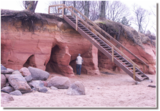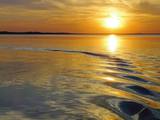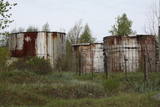| Nr | Nosaukums | Apraksts |
|---|---|---|
|
Ainavisks jūras viļņu izskalots smilšakmens atsegums
dienvidos no Zaķupes ietekas.
|
||
|
Rāznas ezers (57,8 km2), saukts par Latgales jūru, pēc ūdens
ietilpības lielākais Latvijā, atrodas Latgales augstienes Rāznavas paugurainē.
Tā gleznainajā apkārtnē paceļas Latgales augstākās virsotnes un
latgaļu pilskalni. Ezera krastos atrodas iecienītas atpūtas vietas. Lai
pasargātu un saglabātu unikālo dabas kompleksu, izveidots Rāznas
Nacionālais parks un teritorija iekļauta Eiropas Savienības aizsargājamo
teritoriju tīklā Natura 2000. Ezerā ir 10 salas, divi līči. Ezera ūdens līmenis
ir 163,8 m virs jūras līmeņa.
|
||
|
Restorāns atrodas pašā Liepājas centrā, taču mierīgākā nostūrī. "Pastnieka māja" atrodas 5 min brauciena attālumā no jūras. Piemērota vieta, kur paslēpties no ārpasaules. Restorāns izvietots divos stāvos, kuros organizē banketus, seminārus, darījuma pusdienas, ģimenes svinības. Iespējams rezervēt visu restorānu vai atsevišķas tā daļas. |
||
|
Šo sakrālo celtni uzskata par vecāko Zemgales baznīcu, kas joprojām pilda savu pamatfunkciju. Tās celtniecību uzsāka 1567. g. un pēc nopostīšanas atjaunoja 1614. g. Pēc poļu - zviedru un Ziemeļu kara to atkārtoti atjaunoja 1815. g. Dievnamu var apskatīt arī no iekšpuses. |
||
|
Jaunpils attīstība ir saistīta ar Livonijas ordeņa pili, kas līdz mūsdienām gandrīz nav mainījusi savu būvapjomu un ārējo izskatu. Laikā no 1561. - 1919. g. tā piederējusi baronu Reku dzimtai. 1905. g. pili dedzināja, bet vēlāk atjaunoja arhitekta V. Bokslafa vadībā. Būtiskākus pils restaurācijas darbus uzsāka 20. gs. 60. gados. Tagad pilī ir apskatāms muzejs, bet gardēži pils krodziņā var nobaudīt viduslaiku ēdienus. |
||
|
Lietuvas resnākais parastais ozols (Quercus robur). Tā apkārtmērs ir sasniedzis 9,4 m (Latvijas Kaives ozola apkārtmērs – 10,18 m).
|
||
|
1,2 km garā taka atrodas netālu no vietas, kur Gauju šķērso Vidzemes šoseja (A 2). Izejot taku, var iepazīt vienu no Latvijas augstākajiem dolomītiežu atsegumiem – Randātu klintis, kas paceļas 25 m virs Gaujas. Taka ir apļaveida un tās apskatei nepieciešamas ~ 45 minūtes. |
||
|
Valmieras pils celtniecību uzsāka 1283. gadā. Ziemeļu kara laikā (1702. g.) pili nodedzināja, bet 17. gs. beigās nojauca pilsētas ārējos mūrus. Saglabājušās pils drupas un citas viduslaiku nocietinājumu paliekas. |
||
|
Amatnieces darina māla traukus, vāzes, svečturus, lukturus, dārza keramiku un sīkplastikas izstrādājumus. Interesanti ir māla trauki ar koka osām. Piedāvā ekskursiju, podnieka darba vērošanu, iespēju pašam sēsties pie virpas, kā arī iegādāties jau gatavo produkciju. |
||
|
Pils bufete atrodas blakus Kokneses pilsdrupām. Piedāvā pirms vai pēc laivošanas, nūjošanas, pilsdrupu apmeklējuma nobaudīt lielisku kafiju, karstmaizītes, uzkodas, frī kartupeļus, grila desiņas, saldējumu vai iegādāties atspirdzinošu dzērienu, ko uzdzert līdzpaņemtajām sviestmaizēm, sēžot senās pils priekšpagalmā un vērojot teiksmaino skatu uz Pērses un Daugavas krustcelēm. Pēc īpaša lūguma varam arī šeit pagatavot mūsu gardo Ugunszupu. |
||
|
Viesu nams "Aivari" ir atrodams klusā meža ielokā Inčukalna novadā. Piedāvā atpūtu lauku pirtī, pēc pirts iespējams izmantot dušu, atvēsināties baseinā, arī peldi avota dīķītī un koka kublu. Teritorijā ir pieejamas telšu vietas, piknika vieta ar nojumi, volejbola tīkls un vairākas ugunskuru vietas. |
||
|
Karostas kādreizējā raķešu transporta daļa šobrīd netiek izmantota, ir relatīvi iežogota un daļēji slēgta teritorija.
|
||
|
Krodziņš "Glendeloka" atrodas Cēsu – Valmieras ceļa malā. Izvietots guļbaļķu ēkā, latviskā stilā. Dārzeņus un augļus iegādājas no vietējiem zemniekiem. Latviešu virtuve: Plānās un kartupeļu pankūkas, aukstā zupa, meža sēņu zupa, skābeņu zupa „Vecmāmiņas gaumē”, bukstiņputra, pelēkie zirņi, ceptas reņģes, mencas fileja, Brenguļu alū šmorēta liellopa gaļa, šmorēts trusis, rupjmaizes kārtojums. Īpašais ēdiens: „Glendeloka”. |
||
|
Alejas maizes ceptuve atrodas Rucavas novadā. Tajā maize tiek cepta malkas krāsnī un gatavota ar dabīgo ieraugu. Piedāvājumā ir gan dažādas rudzu maizes (parastā rudzu maize, rudzu saldskābā maize ar vai bez piedevām, rudzu augļu maize u.c.), gan dažāda veida baltmaizes. Produktu klāstā ietilpst arī ķiploku grauzdiņi un dažādi miltu izstrādājumi. Produkciju iespējams iegādāties maizes ceptuvē uz vietas, iepriekš sazinoties. Apmeklētājiem tiek piedāvātas meistarklases ar iespēju piedalīties maizes cepšanas procesā un Lejaskurzemei raksturīgo ēdienu gatavošanā, kā arī maizes degustācijas. |
||
|
Rubeņu ziemeļdaļā – Dzirnavupītes krastos ir izveidots (veidošana uzsākta 20. gs. 50. gados) parks ar ainaviskiem dīķiem, estrādi, akmensdārzu un bērnu spēļu laukumiem. Pie parkā esošā kultūras nama novietots 1969. g. Dzejas dienu laikā atklātais Raiņa piemineklis (autors, tēlnieks Kārlis Baumanis). |
||
|
Kafejnīca atrodas Pāvilostas vēsturiskajā daļā pie Pāvilostas pelēkās kāpas un 0,3 km attālumā no jūras. Modernā stilā projektētās ēkas būvniecībā izmantoti Liepājas Karostas ķieģeļi. Plaši logi, vasaras terase. Sadarbojas ar Latvijas mājražotājiem. Latviešu virtuve: marinēta siļķe, zivju zupa uz ugunskura, aukstā zupa, dārzeņu zupa, ceptas butes un mencas, kūpināti asari un vimbas, plānās pankūkas. Īpašais ēdiens: Cepta āte. |
||
|
Lodes muižas ēkas izvietojušās t.s. Lodes – Taurenes subglaciālās iegultnes (cauri tek Gauja) austrumu nogāzē. Muižas apbūve tapusi 19. gs. pirmajā pusē, bet kungu māju (klasicisma stils) cēla 1815. g. Pēdējie īpašnieki, kas šeit saimniekoja (līdz 1939. g.) – bija Šmidtu dzimta. Mūsdienās muižas pilī vasarās dzīvo LU Ģeogrāfijas un Zemes zinātņu fakultātes studenti, kuriem šeit ir lauku prakšu norises vieta. Kungu māja apskatāma no ārpuses. |
||
|
Iespaidīga izmēra divstumbru liepa pie Nigliņu mājām. Viens no iespaidīgākajiem Lībiešu krasta dižkokiem. Lībiešu valodas skolotājas Zojas Sīles dzimtās mājas. Turpat pie mājām atrodas viduslaiku kapsēta – Veckapu kalns. |
||
|
Saimniecība atrodas tradicionālajā zvejnieku ciematā, un šeit ir cieņā vietējie ēdieni un rokdarbi. Viesiem tiek piedāvāts degustēt pašgatavotos produktus, kā arī šeit rīko ēdiena gatavošanas un amatniecības meistarklases un iepazīstina ar lauku dzīvi. |
||
|
Siguldas iepazīšanu var sākt ar Siguldas pilsdrupu apmeklējumu. Pils celtniecību uzsāka Zobenbrāļu ordenis 1207. g., bet 1236. g. to pārbūvēja Livonijas ordeņa vajadzībām. Siguldas pils stipri cieta 16. gs. otrās puses un 17. gs. sākuma karos. Ziemeļu kara laikā to nodedzina un vairāk neatjauno. Šodien ir apskatāms pils konventa ēkas dienvidrietumu korpuss un galveno vārtu tornis, aiz kura atrodas iekšējā priekšpils ar brīvdabas estrādi, no kuras paveras iespaidīgs skats uz Gaujas senleju. Šobrīd notiek pilsdrupu rekonstrukcijas darbi. Dienvidos esošās Siguldas Jaunās pils celtniecība (īpašnieks - kņazs Kropotkins) norisinājās laikā no 1878. - 1881. g. No 1923. - 1940. g ēkā bija Rakstnieku pils, bet Padomju gados - kardioloģijas sanatorija. Kopš 2003. g. te atrodas Siguldas novada dome. Muižas kompleksā ir saglabājusies koka dzīvojamā ēka (19. gs. vidus), kurā atradās Kropotkina ģimenes mājas, klēts (18. - 19. gs. mija), dārznieka māja (19. gs.) un mūra žogs (19. gs.). Ja no Jaunās pils dosimies ziemeļaustrumu virzienā, pēc nepilniem 2 km nonāksim pie Vējupītes gravas. Tajā apskatāma seklā (3,6 m), bet augstā (6,1 m) Pētera ala un dziļā Pūču grava ar Kraukļupīti. Abu upīšu gravu saskares vietā paceļas Satezeles pilskalns (plakums 90 x 75 m), kur 13. gs. sākumā atradās līvu zemes vadoņa (vecākā) - Dabreļa ozolkoka pils. Netālu meklējama Kraukļu aiza - Vējupītes kreisā krasta sānu grava ar 11 m augstām smilšakmens sienām un 5,2 m dziļā Kraukļu ala. Vējupītes gravas un Gaujas senlejas saskares vietā slejas Paradīzes (Gleznotāju) kalns - ļoti ainaviska vieta, kas gleznota un fotografēta kopš seniem laikiem. Līdz Paradīzes kalnam var nokļūt arī ar elektromobili. Siguldas rietumdaļā var apmeklēt Panorāmas ratu (darbojas vasaras laikā) un Gaisa trošu ceļu (tramvajs) - Baltijas valstīs vienīgo (celts 1969. g.) šāda tipa transporta līdzekli. Tā nesošā trose stiepjas 1060 m garumā un bez atbalstiem savieno Gaujas senlejas krastus starp Siguldu un Krimuldu ~ 40 m augstumā virs Gaujas. Te paveras izcili skati! Siguldas dienvidrietumu daļā var aizstaigāt līdz varenajai Beites kraujai, kuru pāršķeļ dziļa strauta grava. Gravas rietumu pusē meklējams Ķeizarskats, kas atrodas ~ 67 m virs Gaujas līmeņa ar labu skatu uz Krimuldu un Turaidas pili. Skatu vietu šeit iekārtoja jau 1862. g. kad Siguldā viesojies Krievijas cars Aleksandrs II. Gravas austrumu pusē novietots no koka veidotais Ķeizarkrēsls. |
||





















